Cheongju National Museum
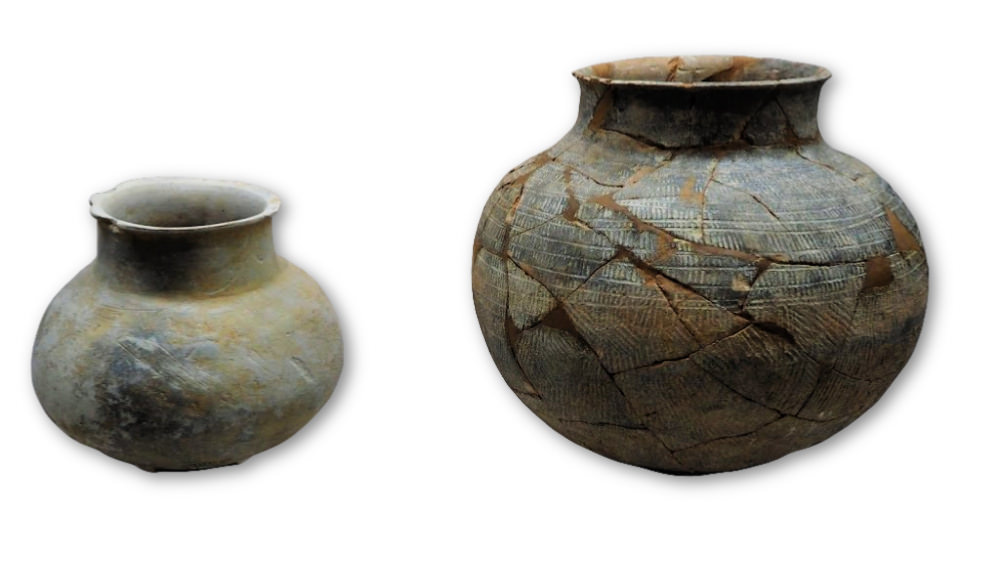 Mud potteries at Cheongju National Museum [Abbie]
Mud potteries at Cheongju National Museum [Abbie]Introduction
Cheongju National Museum should be one of your must-visit places when in Cheongju. It is a great place to explore and appreciate the ancient culture of Korea.
The museum houses many artifacts, relics, documents and records that provide an insight into the history of Cheongju and its people.
There are also interactive exhibitions where visitors can learn about traditional crafts, architecture, music and more. The museum also organizes various activities like lectures, workshops and performances throughout the year.
So if you are looking for an interesting way to experience traditional Korean culture, Cheongju National Museum should not be missed!
Visiting the museum is easy as it's located in the heart of Cheongju city and easily accessible by public transport or taxi. The entrance fee is very reasonable and there are discounts available for students, seniors and military personnel. There is also a café offering snacks and drinks if you need to take a break during your visit.
So don't forget to check out Cheongju National Museum when you are in the area – it's an experience you won't forget!
If you are looking for more information about Cheongju National Museum, please visit the official website at https://www.cheongju-museum.go.kr/. You can also find out what events are happening in the area by checking out their Twitter page or subscribing to their newsletter for regular updates. We hope you enjoy your visit!
Once you're done exploring Cheongju National Museum, make sure to visit the Cheongju Traditional Crafts Exhibition Hall. This exhibition hall showcases traditional crafts from Korea and offers a unique opportunity to learn about the history of various Korean craft traditions.
You can buy craft souvenirs for yourself or as gifts and explore interactive exhibits that teach you more about Korean culture and arts. Don't miss this chance to get an up close and personal look at the history of Korea through its traditional craft!
After you've spent some time exploring the museum and exhibition hall, take a stroll around Cheongju Castle. This ancient fortress was built in 940 AD by King Gyeongsun and has been restored several times over the centuries.
It is now one of the most popular tourist sites in Cheongju and a perfect spot for sightseeing. From the castle walls, you can catch glimpses of the countryside around Cheongju. Don't forget to take photos while you're there!
When you're done with your tour of the castle, why not check out some of the nearby restaurants and cafes? Cheongju is known for its delicious food, and there are plenty of options to choose from.
From traditional Korean fare to fusion dishes, you'll be sure to find something that tickles your tastebuds. And wash it all down with a cup of freshly brewed aromatic tea - Cheongju's specialty!
After you've filled up on some tasty food, take a walk around the city. Cheongju is rich with cultural heritage and monuments, such as the old traditional houses in Jogye-dong or the Yongdusan Park. Admire the grandiose architecture of some of Cheongju's historical buildings like Jikji Pavillion and Sangdangsanseong Fortress.
If you're looking for a more shopping-focused experience, Cheongju's Naejangsan Market and Jungang Market are the perfect places to explore. From traditional souvenirs to the latest fashion trends, find whatever it is that you're looking for in these bustling markets!
Cheongju is definitely worth spending some time in, and the perfect way to end a day of sightseeing is with a cup of freshly brewed aromatic tea - Cheongju's specialty! Enjoy your stay in this vibrant city.
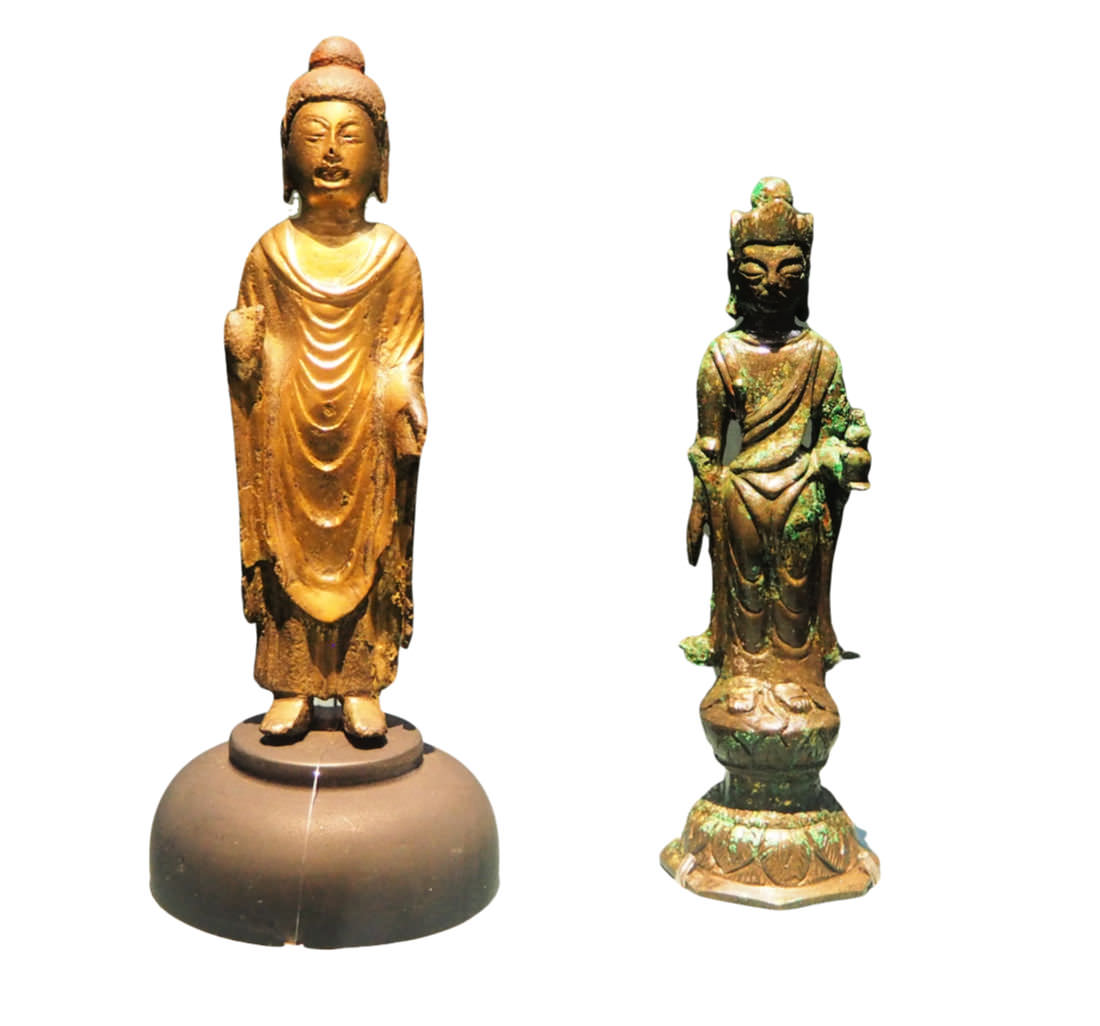 Cheongju National Museum Standing Buddha Statues
Cheongju National Museum Standing Buddha StatuesCheongju National Museum
Cheongju National Museum is one of the best places I have explored and enjoyed in my Cheongju City visit. Different from most museums, Cheongju Museum is located on a hillside outside the downtown with fantastic verdant surroundings.
The museum houses fascinating artifacts and items of various historical origins. The main museum has four galleries, namely:
- Prehistory Gallery
- Ancient History Gallery
- Goryeo Dynasty Gallery
- Joseon Dynasty Gallery
Indeed, the artifacts are not limited to those galleries. It also houses other objects that were excavated in Chungcheongbuk-do (Province).
Aside from the main building that houses the four galleries, other structures and spaces surrounding it each with other exciting functions and items are worth seeing. They are...
- Cheongmyeonggwan Hall Special Exhibition Gallery
- Children's Museum--Metal Story of Cultural Property, Experience Room, etc.
- Auditorium
- Cheongnyeongwan Hall
- Outdoor Exhibition
- Outdoor Stage (for events)
- Munhwasarangchae Hall, Book Cafe
The whole area is quite spacious, which offers a relaxing venue and space to do a small picnic with friends and family.
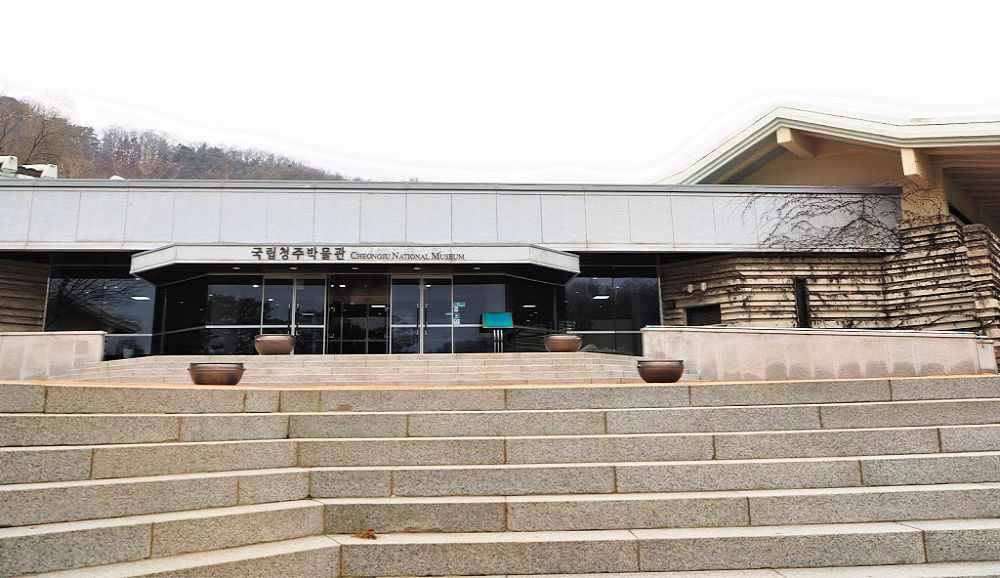 Entrance area of Cheongju City's national museum
Entrance area of Cheongju City's national museum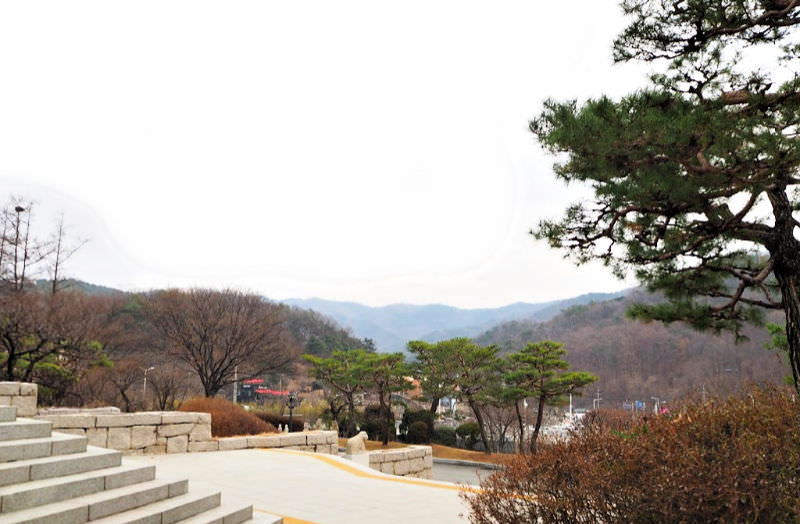 View from Cheongju National Museum
View from Cheongju National MuseumAs a brief historical background of the museum, let me enumerate the chronology of its establishment as follow...
1978 August: the land was donated for the buildings
1982 Mar 16: Construction commenced
1987 Jul 20: Construction completed
1987 Aug 17: Established an organization
1987 Oct 30: Opening
1998 Jul 22: Children's Hall was opened
2004 Oct 8: Cheongmyeonggwan Hall was opened
2011 Dec 20: Exhibition Halls renovations
When I started moving uphill, I didn't waste time but went looking for the main hall and towards the entrance. I was sure it was the main building as it mentioned the museum's full name.
It was the time when Coronavirus Disease (COVID-19) started to spread slowly. So, as I went in with my mask on, I looked for the hand sanitizer and sanitized my hands. Gently greeted the young staff at the Front Desk. I headed towards the direction of the arrow, pointing to the first gallery with much excitement.
Now, what I want to do is describe each gallery chronologically. Since I cannot describe everything, let me include the photos which I think would make you get interested. I hope!
Prehistory Gallery
The moment I entered, I know that it would look quite familiar to me. I know that I will see stone tools, among other ancient items.
The gallery brings visitors to the prehistoric time and culture that shaped the present Chungcheongbuk-do province. Here, you will see the artifacts from the Paleolithic Age to the Early Iron Age.
Most of the artifacts were excavated and uncovered at various archaeological sites around the Namhangang and Geumgang Rivers in the province.
The artifacts describe how the Neolithic settlers in the area lived by farming. They made and used potteries. The Bronze Age settlers, on the other hand, used stone tools for farming rice and other grains as a staple food.
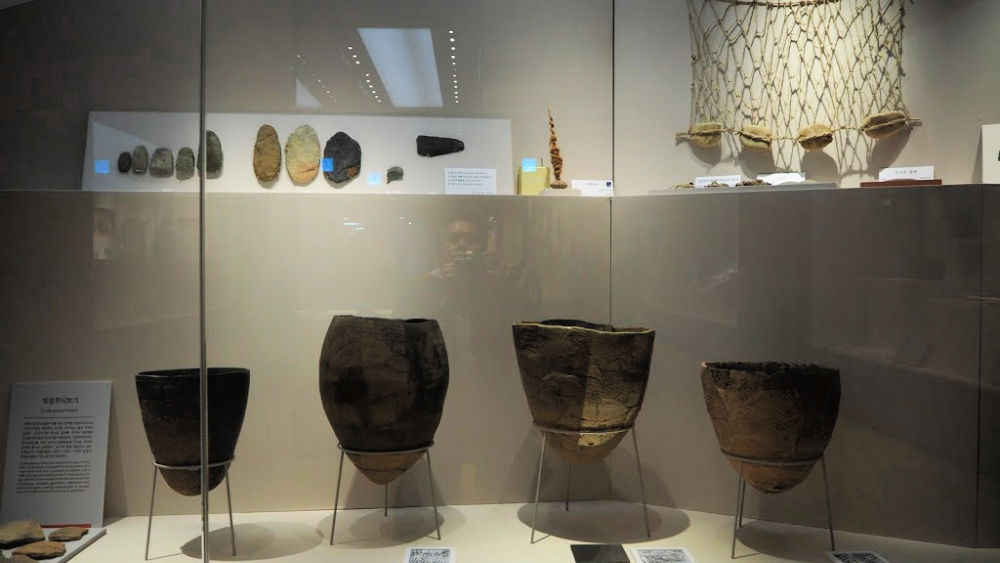 Ancient stone tools, fishing net, water jars
Ancient stone tools, fishing net, water jars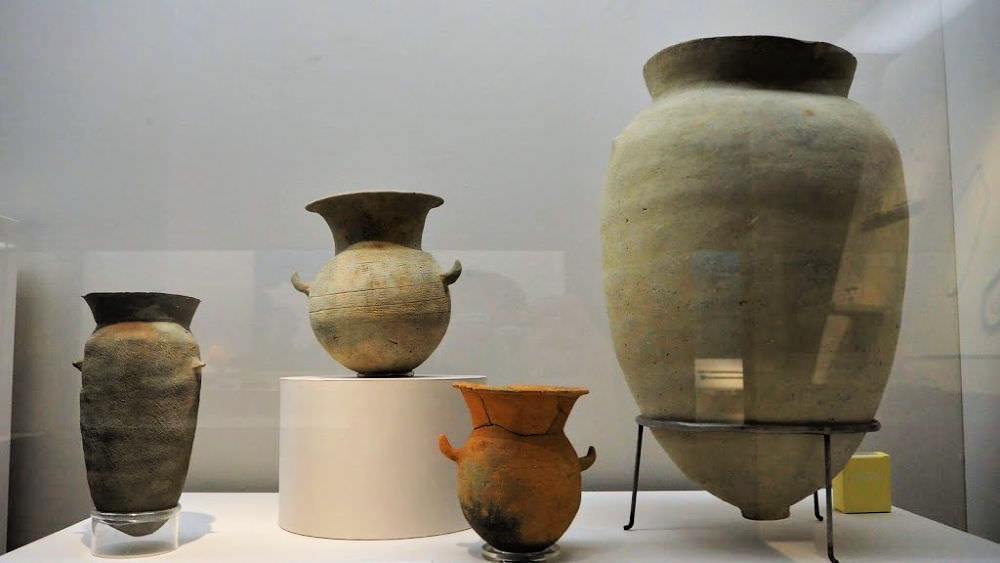 Earthen Jars and jugs
Earthen Jars and jugs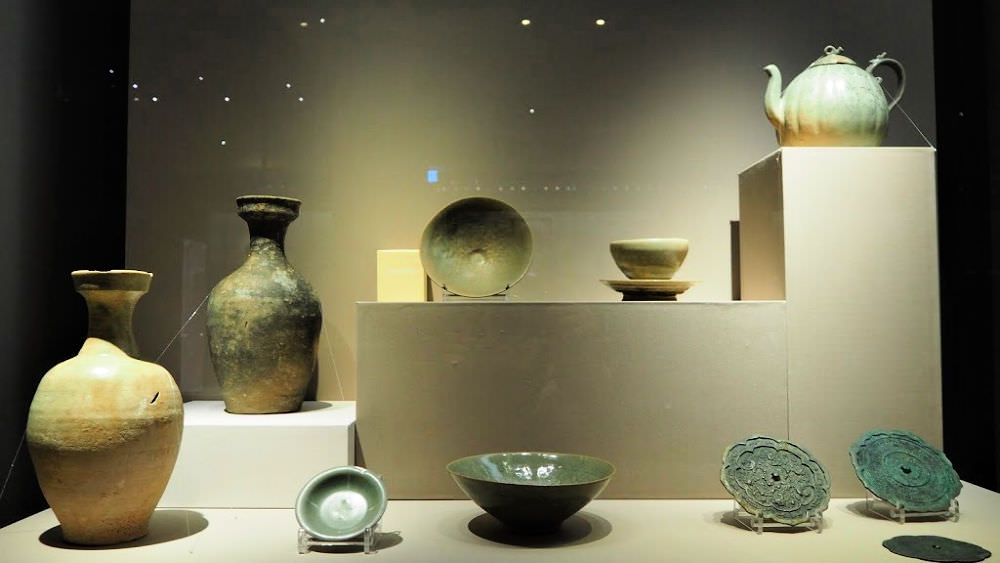 Ancient artifacts - ewer, jug, base, bronze mirrors, dishes, etc.
Ancient artifacts - ewer, jug, base, bronze mirrors, dishes, etc.More Artifacts
Handaxe
Tanged Points
Grinding Stones
Pottery
Bronze Mirrors
Having satisfied my curiosity, I moved to the next gallery...
Ancient History Gallery
This gallery exhibits ancient artifacts, including Buddhist sculptures that were unearthed from archaeological sites, including residences, tombs, fortress walls, and other sites.
The archaeological finds date back to the Samhan Period (300 BCE-300 CE) up to the Unified Silla Period (676-935 CE).
All the findings testify the fact that Chungcheongbuk-do Province people have experienced various stages of cultural development and competition among the three kingdoms: Silla, Baekje, and Goguryeo.
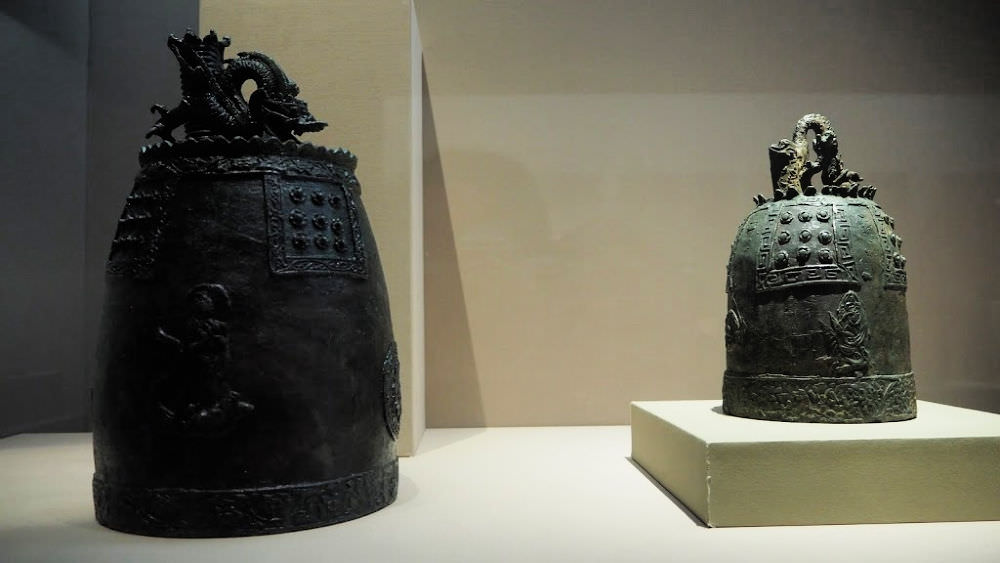 Decorative bronze bells
Decorative bronze bells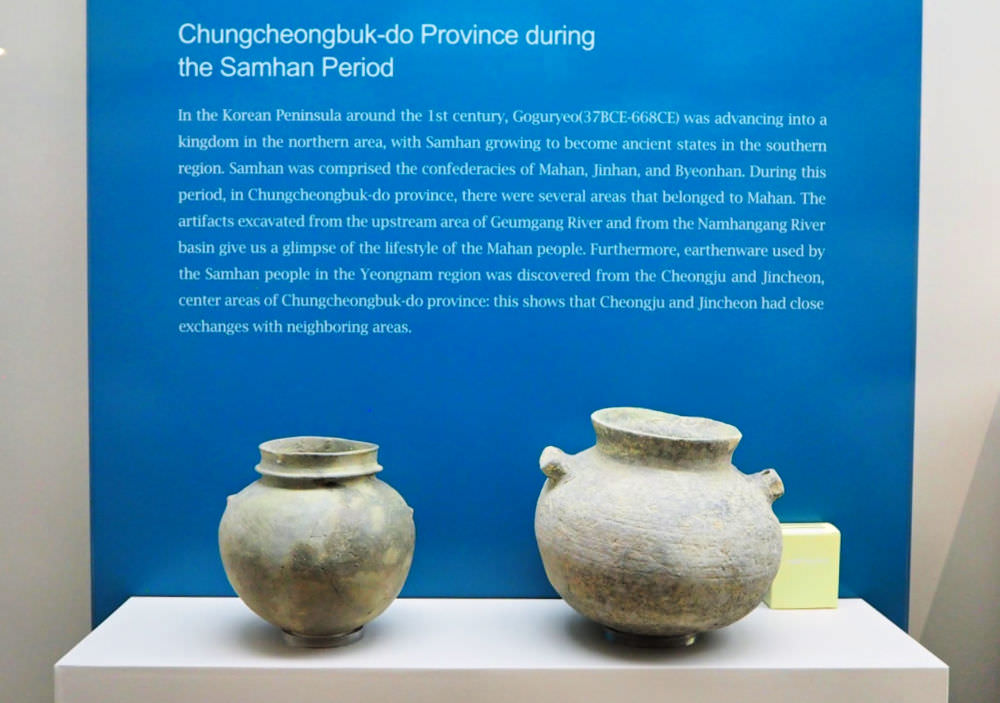 Pottery artifacts from Samhan Period, Cheongju Museum
Pottery artifacts from Samhan Period, Cheongju Museum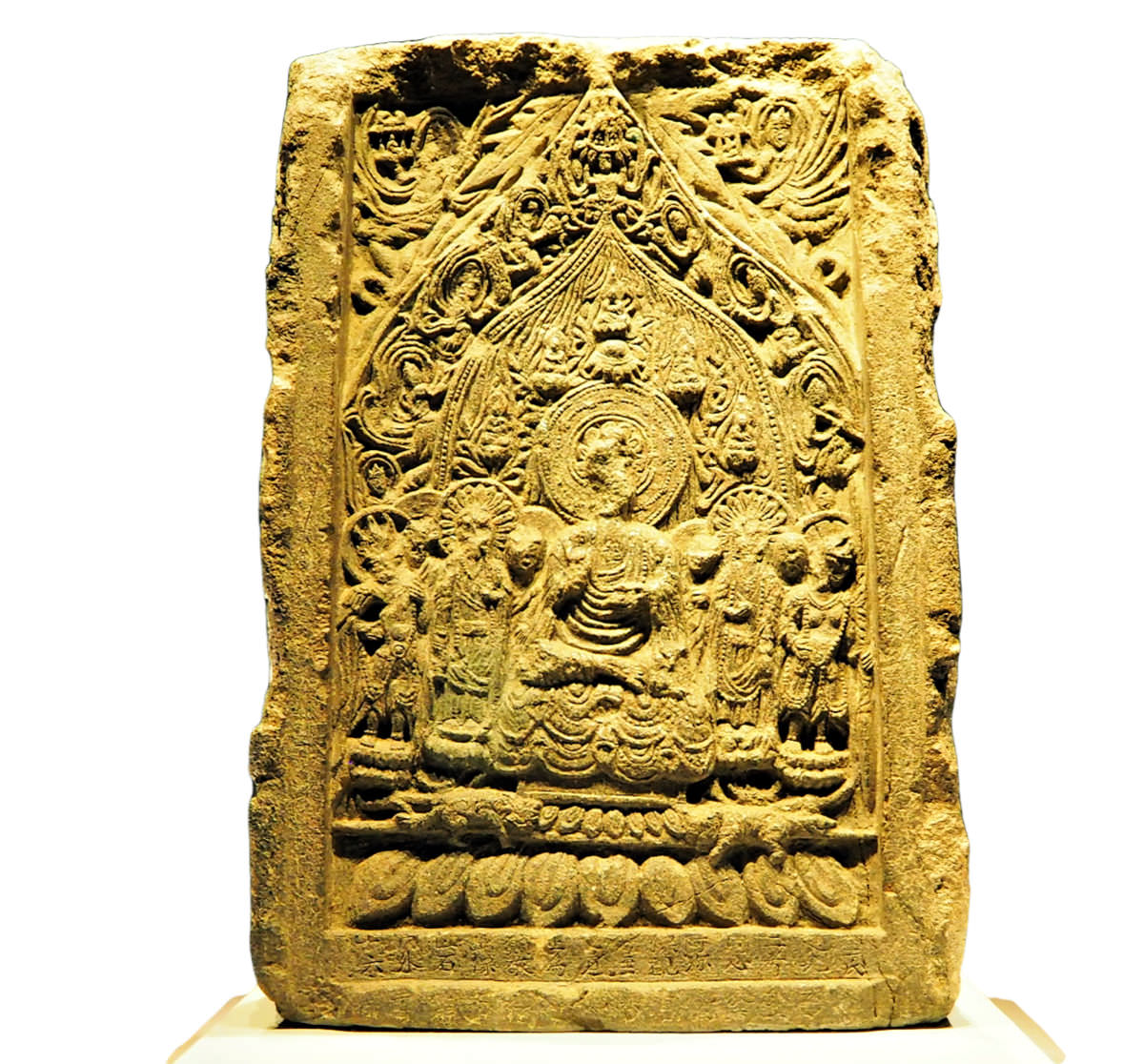 Amitabha Buddha Stele at Cheongju Museum
Amitabha Buddha Stele at Cheongju MuseumMore Artifacts
Bronze Bell
Armor
Horse-head-shaped Vessel handle
Earrings
Bronze Crown
Amitabha Buddha Stele
Stele from a Buddhist Temple
Having scoured the exhibits, but deliberately choosing only those I thought were very significant (I guess they all are significant!). Next gallery...
Goryeo Dynasty Gallery
During the Goryeo Dynasty (918-1392) period, Chungcheongbuk-do province was called Yanggwangdo.
The Buddhist religion culture flourished in this region as royal and powerful families controlled the area. It means that Buddhist religious beliefs influenced the development and culture.
The construction of the temples was sponsored by the affluent royal families and powerful clans.
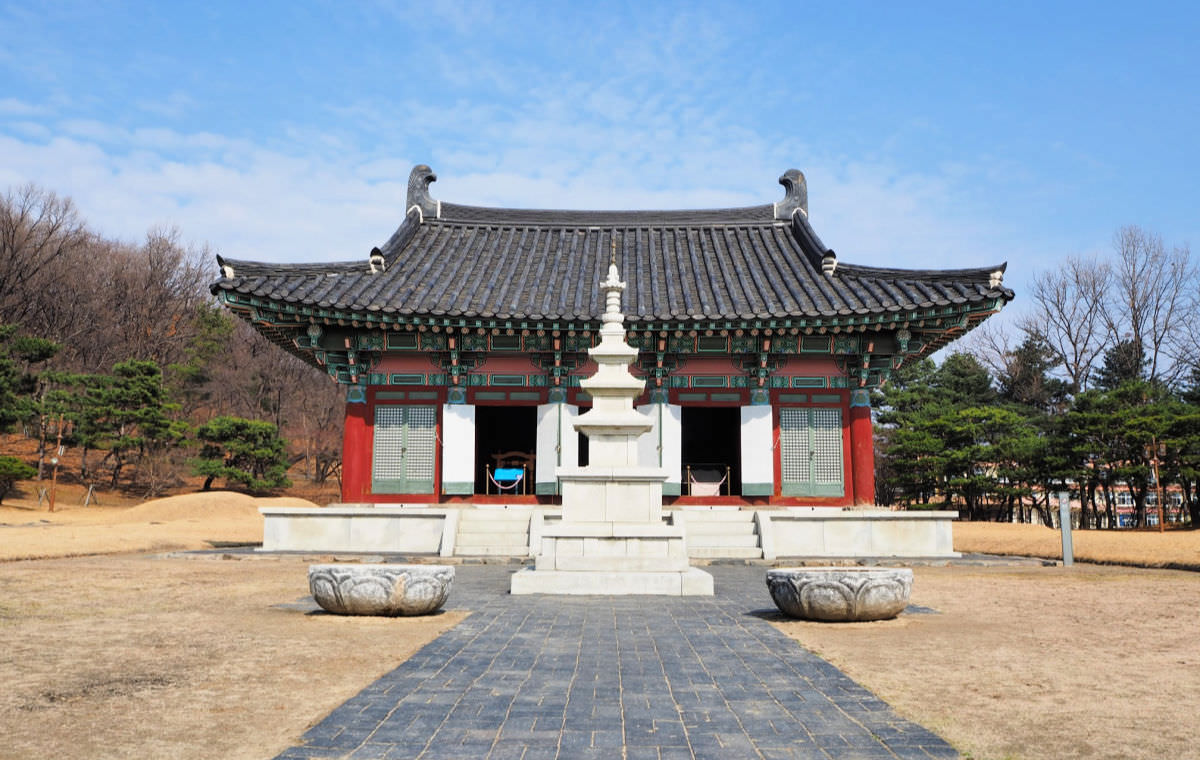 Heungdeoksa Temple, Cheongju City
Heungdeoksa Temple, Cheongju City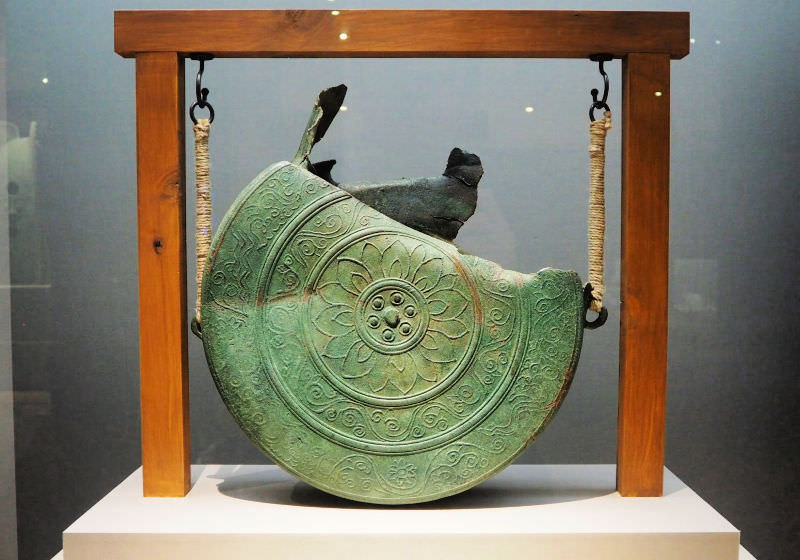 Buddhist Bronze Gong
Buddhist Bronze Gong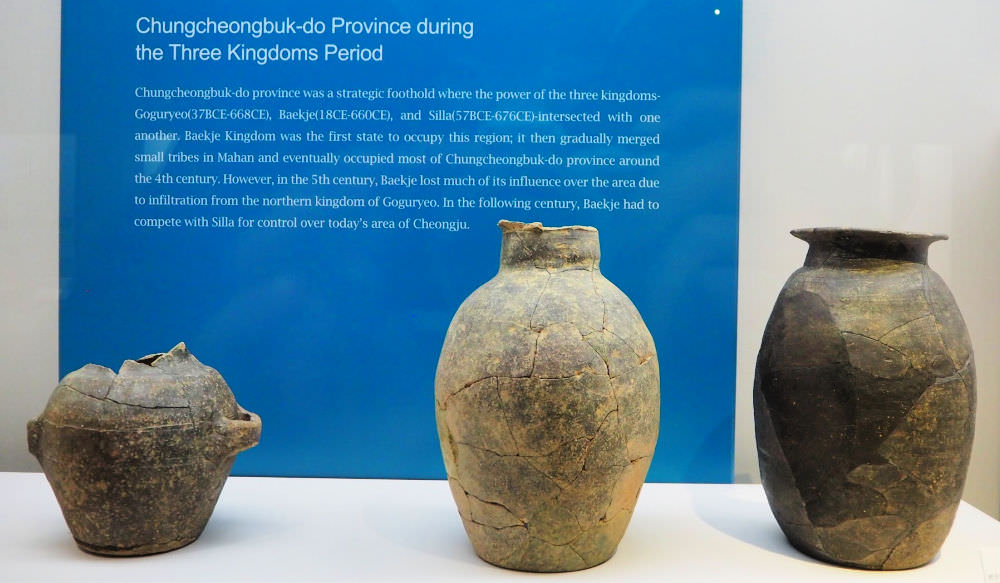 Pottery artifacts from the Three Kingdoms at Cheongju National Museum
Pottery artifacts from the Three Kingdoms at Cheongju National MuseumHeungdeoksa Temple was one of those temples built and supported by those families. Since they have the resources, they developed various cultural legacies, including the invention of the Buddhist scriptures printed with supposedly the world's oldest metal type.
The photos below describe the lifestyles of the people at various periods.
Artifacts
Inkstick
Buddhist Bell
Mangsae-Ridge-end Tile
Incense Burner
Buddhist Gong
I took lots of photos in this hall, and I saw my camera running out of battery. Unfortunately, my backup battery was also used up. With the remaining bar, I hurried to the next and last hall and sparingly taking photos I thought very useful for this article.
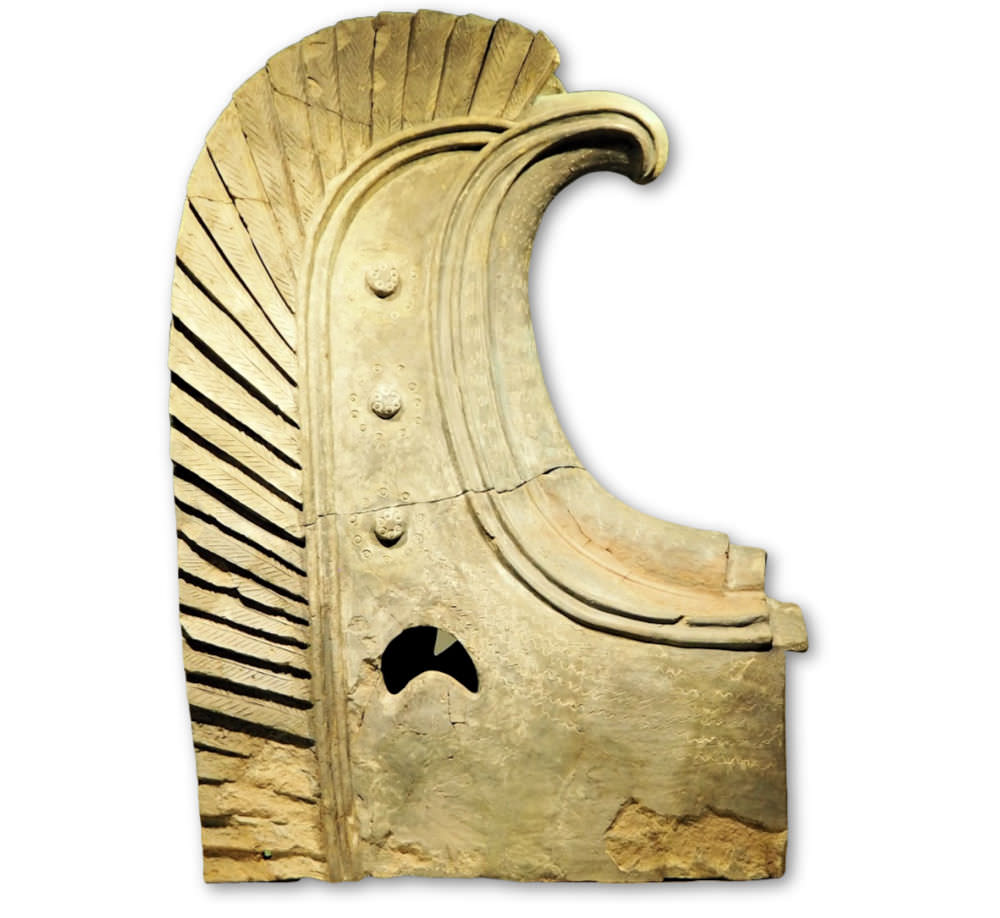 Mangsae Ridge-end Tile Design
Mangsae Ridge-end Tile DesignJoseon Dynasty Gallery
This gallery offers an overview of the Joseon period's residents during the 1392-1910 period. You can find various products of porcelain produced in Chungcheongbuk-do Province.
A lot of household and funeral artifacts provide us glimpses of their culture. Some tableware and accessories date back to the 15th-17th centuries.
Samples of the most significant finds include the books, portraits, written scripts, calligraphy, and other historical treasures produced by officials and scholars of the period.
Artifacts
Wooden Figures for funerals
Portrait of Choe Seokjeong
Collection of Letters
Large Seongja Chongtong Gun
There are more to see besides my descriptions and photos included here. Of course, if you feel exhausted and wanted to take a break, there are seats and areas where you can slow down.
Business Hours
Cheongju National Museum is accessible by the public during...
Tuesday to Friday: 10 AM to 6 PM
Saturday (April-October): 10 AM to 9 PM
Saturday (Jan-Mar, Nov-Dec): 10 AM to 7 PM
Sunday/Public Holidays: 10 AM to 7 PM
However, Cheongju National Museum is NOT open on...
Mondays, New Year's Day, Seollal (Lunar New Year), Chuseok (Thanksgiving days).
Other Useful Information
Phone: +82-43-229-6300
Website: https://www.cheongju.museum.go.kr
Public Facilities
Rest Room / Washrooms
Rental Service (wheelchairs, baby carriers)
Cafe and sitting areas
Nursing Room
Parking Area
Getting to Cheongju National Museum
You can get there quickly as you have choices of transports, including private cars, buses, and taxis.
No need to provide a guide for a private vehicle because you can use your navigator.
By Bus
From Cheongju Downtown, you can take a bus from Chungbuk Provincial Government Office (and other bus stops nearby) with numbers 862-1, 862-2, 863-1, and 863-2. Then get off at Cheongju Museum. Don't worry because it will be announced in various languages, including English, Japanese, and Chinese.
By Taxi
Simply tell your driver to bring you to the museum. You can say the name in English. But if you prefer, you can write down the Korean word: 국깁청주박물관. That's the literal translation for Cheongju National Museum.
From Cheongju Downtown, it will take around 20 minutes to get there. Of course, it depends on where or which hotel you are staying in. If you asked me, stayed in a hotel at the center of the downtown where the actions are.
My Judgement?
I highly recommend it. It is worth visiting. It is like finding gold and other treasures. Only they are not yours! They are world heritage (not enlisted), but part of human history.
Second, it is not time-consuming to get there if you are already in Cheongju City. A bus is fine. A taxi is faster and inexpensive in Korea.
Third, you can visit other attractions nearby--Cheongju Land (check it out). And if already here, take a bus for Sangdang Mountain Fortress. It's only around 15 to 20 minutes, I think, to get there. I strongly recommend visiting those ancient mountain walls.
Now, if you have questions or any, please drop me a line.
Thanks for reading and enjoy your travels.
- Home
- Chungbuk Province Travel Attractions
- Cheongju National Museum
Get Exciting Activities
Book one of our exciting activities today to experience the thrill of a lifetime! Take advantage of this opportunity and secure your spot in advance.
Hotel Map Guide
Find your affordable, accessible, and comfortable hotel in Seoul at Agoda.Com. See the hotel map below...
Hotel Booking Guide
Find affordable and amazing hotels on Agoda.com using the search box below. Book now to enjoy great discounts and save!
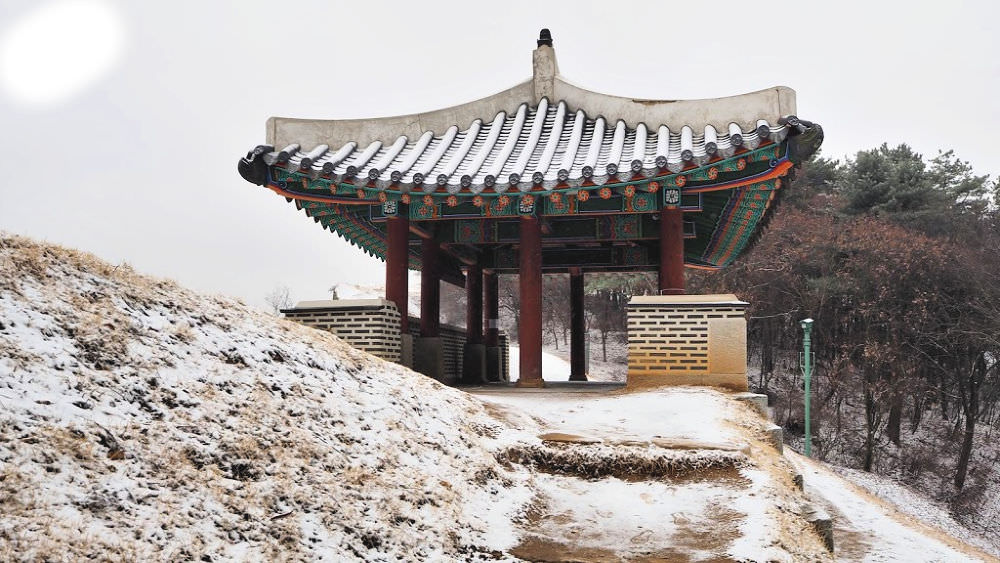

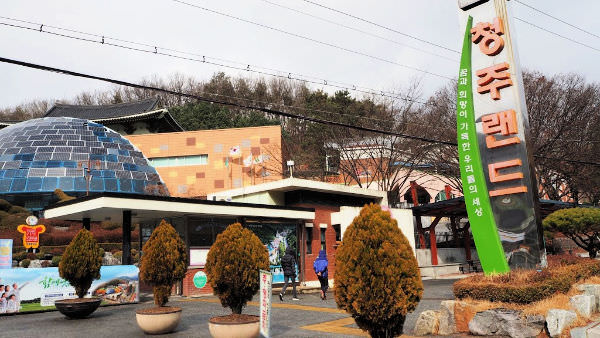




New! Comments
What do you think about this page? Leave me a comment in the box below.